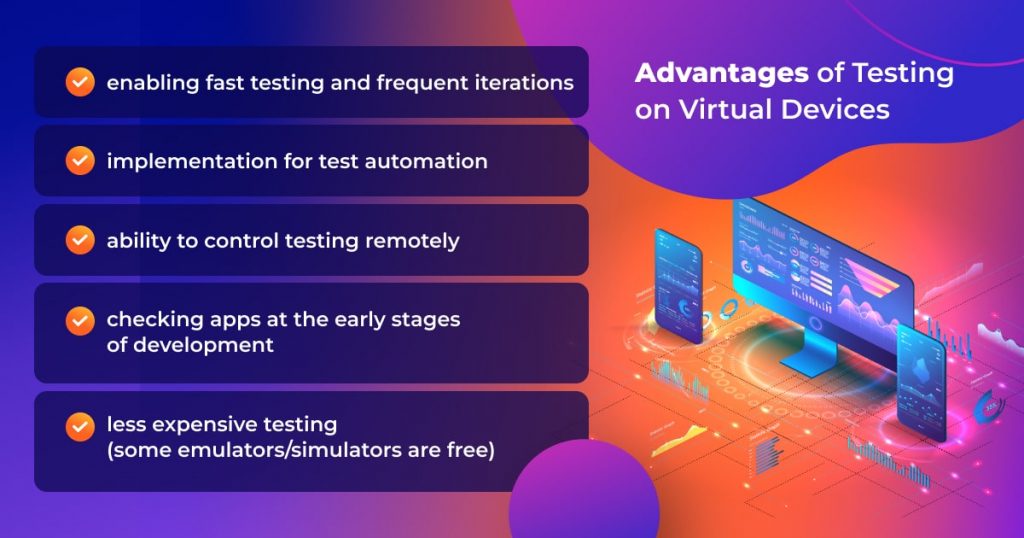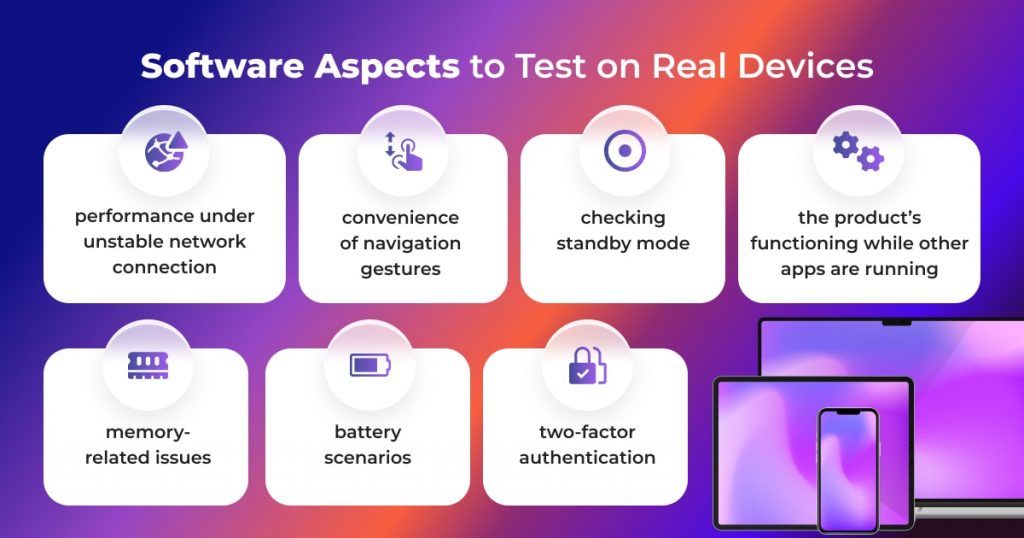- QATestLab Blog >
- Mobile Testing >
- Testing on Real Devices — Just an Option or a Necessity?
Testing on Real Devices — Just an Option or a Necessity?

According to Statista research, consumers are expected to download 143 billion mobile apps from the Google Play Store in 2026. This is 30% more than in 2021, when users installed 111 billion apps. Also, consumers will have approximately 38 billion downloads from the Apple app store in 2026, an increase of roughly 15% over 2021 installs. This research shows that the importance of mobile app development will continue to grow. Optimizing a software product has become a top priority for companies looking to stay ahead and deliver exactly what their target audience wants and expects.
From the QA point of view, there are two ways to check the performance of a mobile application and the quality of its interaction with the end-user — either testing it with the help of real devices or virtual ones. In this article, we will discuss the differences between these two methods and examine the cases when manual checks on real devices should definitely be included in the mobile testing strategy. So, let’s start with the basics.
Testing on Virtual Devices
What does it mean?
Virtual devices are set up to create necessary testing conditions and check how the software will operate in a specified environment without using an actual gadget. They can reproduce the work of devices, browsers, or operational systems. Such tools fall into two categories — emulators and simulators.
Emulators mimic the hardware and software configuration of a target device on a tester’s computer and help to identify whether the final goal of using a certain solution can be achieved. Simulators, on the other hand, reproduce the functioning of a software product built for another OS but can’t replicate hardware. To better illustrate the difference between these two types of virtual testing devices, we can use an example of modeling a car ride. A car simulator would mimic the mechanics of a vehicle and the surrounding environment with the help of a computer-generated program (like they do for training pilots or astronauts). An emulator of a car would actually give you the opportunity to reach your destination with the impression that you were taken there by a car.
When to use virtual devices for mobile testing?
It is best to perform checks on emulators and simulators early in the development cycle, when you don’t need the accurate representation of interactions between the user and a mobile app, but rather want to see a general picture and test the product on a local machine. Virtual devices are also perfect for unit testing, when QA engineers verify isolated parts of code.

Testing on Real Devices
According to research by AppsFlyer, around 50% of mobile apps are uninstalled within the first 30 days. Broken functionality after OS updates is one of the crucial aspects here. Verification of mobile software on physical devices allows developers to not only recreate the target environment with all its specifications but also obtain accurate user feedback on the accessibility and usability of a product. App crashes and critical defects are definitely a huge issue, yet sometimes it is all about inconvenience. QATestLab provides an extensive range of 500+ real devices to ensure comprehensive testing for your application. Here, you can choose the perfect selection of physical devices to meet your quality assurance needs.
While testing a solution manually on a real mobile device, QA engineers often find unexpected problems, which could never be detected by a virtual tool. One of the brightest examples of such defects are interface elements that are situated in the wrong place on a screen or touch targets that are not finger-friendly. How long will you be able to continue using an app if you can’t reach a button without using a second hand? Or if you can’t manage to tap a clickable element because it’s too small for your finger? All this leads us to particular cases when checking a product on real devices is absolutely necessary.

#1 Performance defects related to the target device or the environment
In this category of tests, QA engineers check what happens with the mobile application under an unstable network connection and how it affects its speed.
#2 Compatibility issues
If there are troubles with the app operating on a particular device, compatibility testing on a real gadget will allow you to quickly detect the cause of malfunctioning.
#3 Fast replication of bug reports and instant feedback
To accurately replicate a user bug report with the help of virtual devices, it is necessary to set up a testing framework, indicate requirements for a particular test case, create test scenarios, and only then run the test. Using a real device enables you to follow the steps of a bug report quickly and get immediate results.
#4 UX/UI testing
These types of software checks also lead to informative outcomes only by verifying mobile apps on physical gadgets. Here QA engineers check whether an application and its interface elements are user-friendly and accessible. For instance, they perform different navigation gestures (scrolling up and down, zooming, pressing a button, etc.) and provide feedback on how easy it is to fulfill user goals with the software. Experienced specialists will not only estimate the usability of a mobile app, but also provide the development team with practical ways to improve UX/UI interactions.
#5 Battery and memory-related issues
With the help of real devices, testers can look at different battery scenarios, like what will happen when it is overheated or whether the application leads to this issue. In terms of storage capacity, actual gadgets are also more fitting for testing, since the memory on them is much more limited than while using virtual tools.
#6 Checking a product while other apps are running
There are so many scenarios to test here, as usually there is more than one application functioning on a smartphone or a tab. This way, manual testing on physical devices allows to find out what will happen to an app if someone calls a user while the software is running, or if a notification from another application pops up.
Q&A Checklist to Choose Between Virtual Testing and Testing on Real Devices?
Before deciding between virtual and real device testing, it’s important to consider key questions that can guide your choice. This can help you better understand your testing goals, resource constraints, and the unique characteristics of each method to ensure you choose the approach that best suits your product’s needs.
Does your product rely on external factors like network conditions, battery performance, or the environment?
- Real Devices: Allows to perform accurate testing under unstable network conditions, real-world battery drain, and environmental factors such as temperature or light exposure.
- Virtual Environments: While useful for controlled simulations, they cannot fully reproduce unpredictable real-world scenarios.
Does your app rely on the OS or development components/framework versions?
- Virtual Environments: Enables rapid switching between operating system versions and development components/framework versions.
- Real Devices: Crucial when targeting rare, older, or fragmented devices that virtual tools struggle to simulate accurately.
Do you require integration tests with other hardware?
- Real Devices: Necessary when testing integrations with hardware such as Bluetooth devices, NFC systems, smartwatches, GPS modules, or IoT gadgets.
- Virtual environments can’t provide fully accurate results when testing complex integrations with other real gadgets.
What are the scope and timeframe of your testing process?
- Virtual Environments: Ideal for short-term testing requiring broad coverage across multiple devices, OS versions, and configurations. They accelerate testing cycles and enable rapid iterations.
- Testing on real devices is an excellent choice for long-term testing because it provides the most authentic and reliable insights into how a product performs over time in real-world conditions.
What kind of functionality are you testing?
- Virtual Environments: Sufficient for validating software logic and core functionality without relying on hardware-specific features.
- Real Devices: Required when testing features that depend on hardware components, such as GPS, cameras, biometric sensors, and physical buttons. Real devices ensure accurate behavior in real-world conditions.
Which technology stack is your software built on?
- Virtual environments might miss many edge cases that depend on the particular technology stack.
- Swift, Kotlin, Flutter, React Native, etc. need testing on real devices to ensure consistent performance across both iOS and Android environments, especially after updates.
And the winner is…
To release a mobile application that will satisfy the users and stay on their gadgets for a long time, it is important to come up with a smart and customized testing strategy that will include both testing on virtual devices and on real ones. To gain more in-depth knowledge about mobile app testing, click here.
Checking software on actual gadgets shouldn’t be considered an optional addition to virtual testing tools. This method is the best way to ensure that an end-user of an application will not be the one to find a critical bug, which helps to avoid reputational losses and high uninstall rates.
However, owning and restocking a whole device lab made up of at least several dozens of gadgets is rarely a reasonable solution for businesses. This is why QATestLab offers our extensive pool of mobile gadgets, which includes more than 500 devices. Contact us and we will make sure to select the necessary types and versions of devices, browsers, and OS to boost the quality of your application for every user.

Learn more from QATestLab
Related Posts:
- Automation Testing for Mobile Apps: Why It’s Essential and Our Key Services
- How One Bug Can Wreck Your Reputation — And How QA Prevents It
- Top 5 Mobile App Development Trends to Consider in 2024
About Article Author
view more articles







No Comments Yet!
You can be the one to start a conversation.